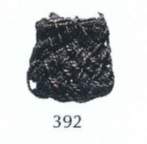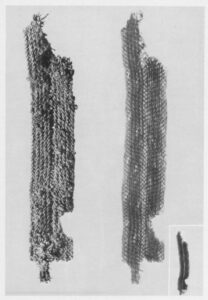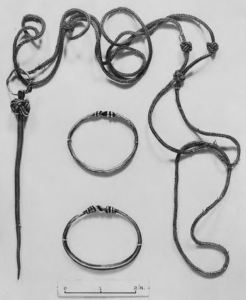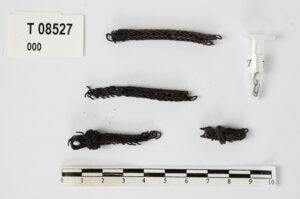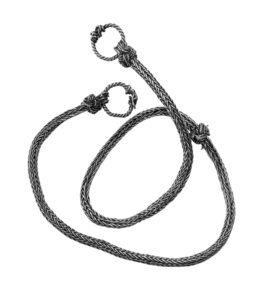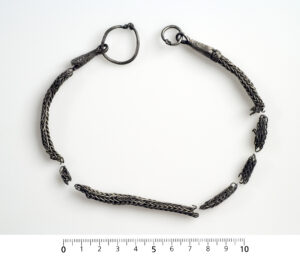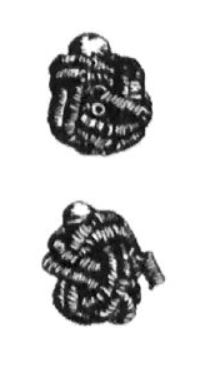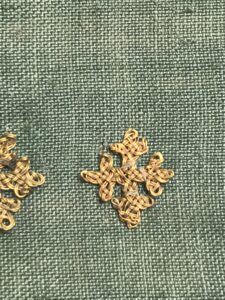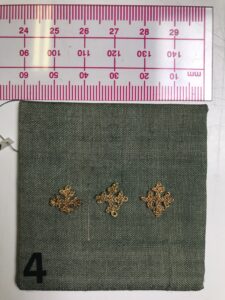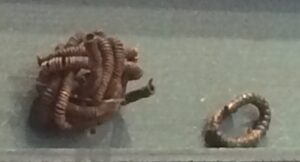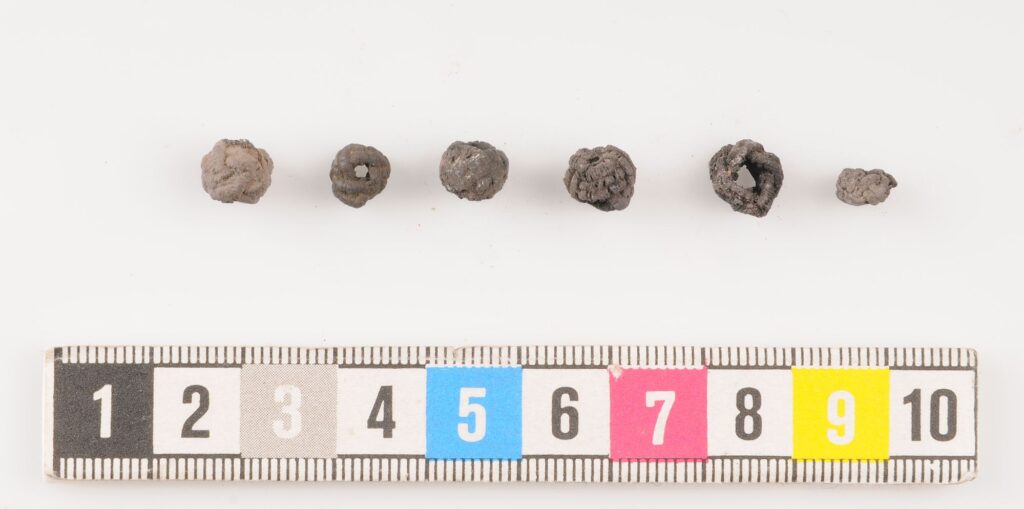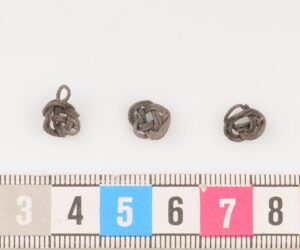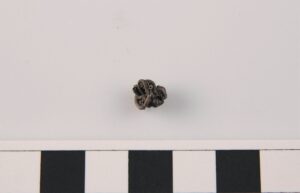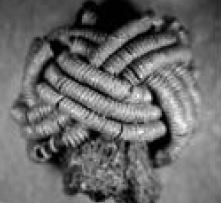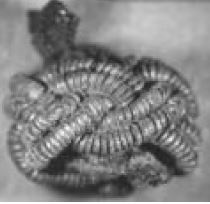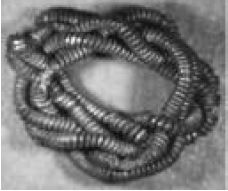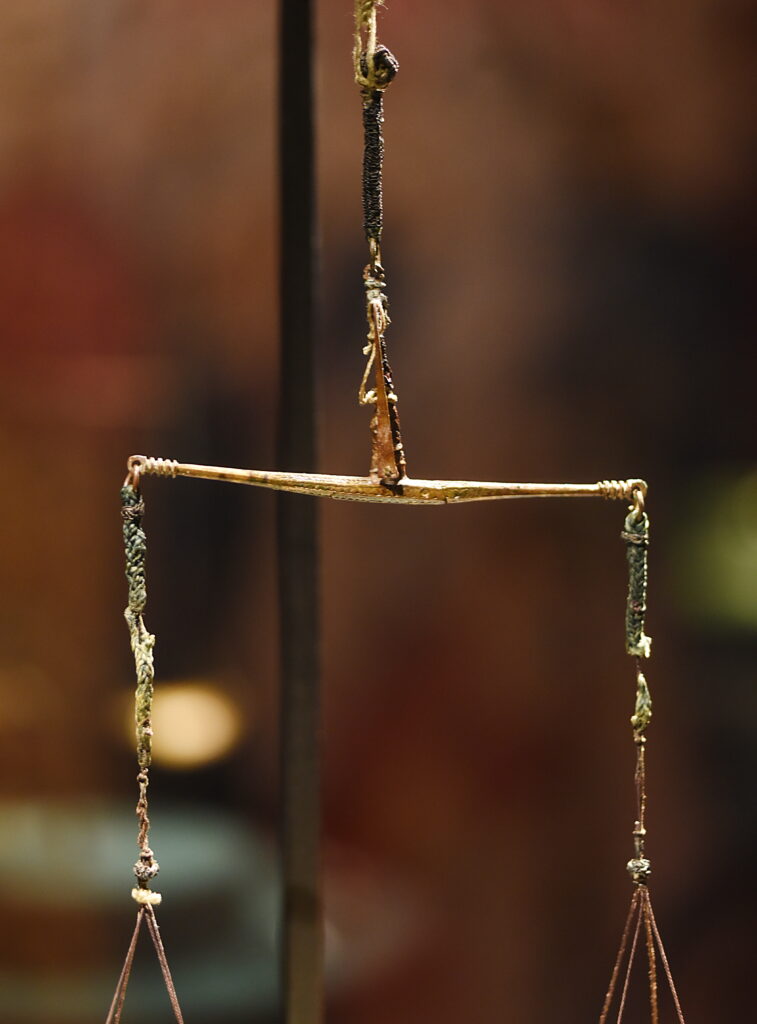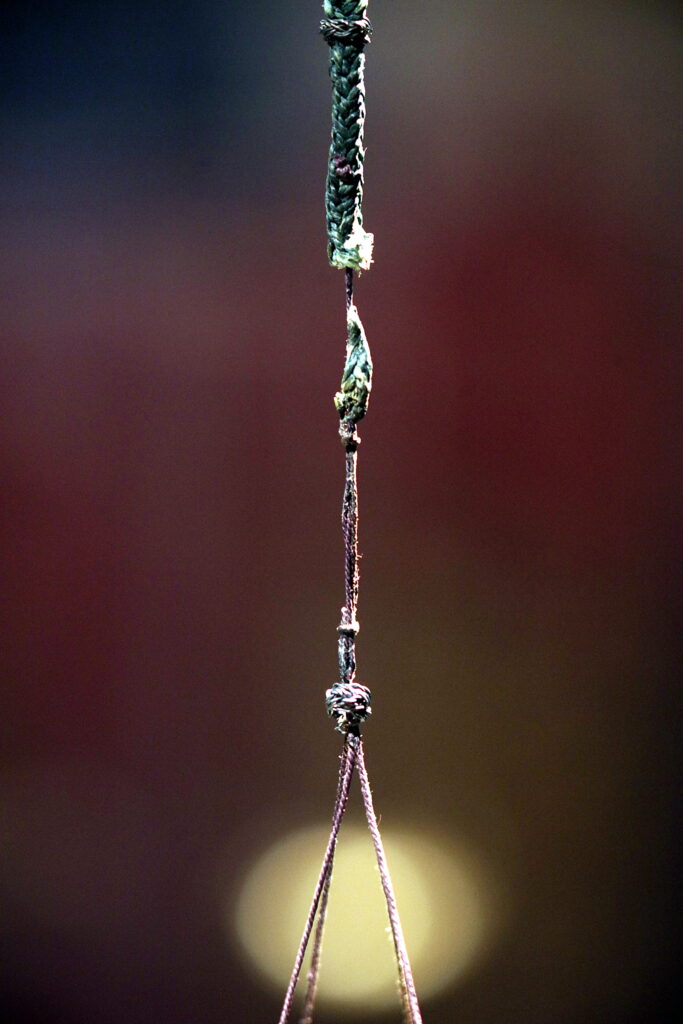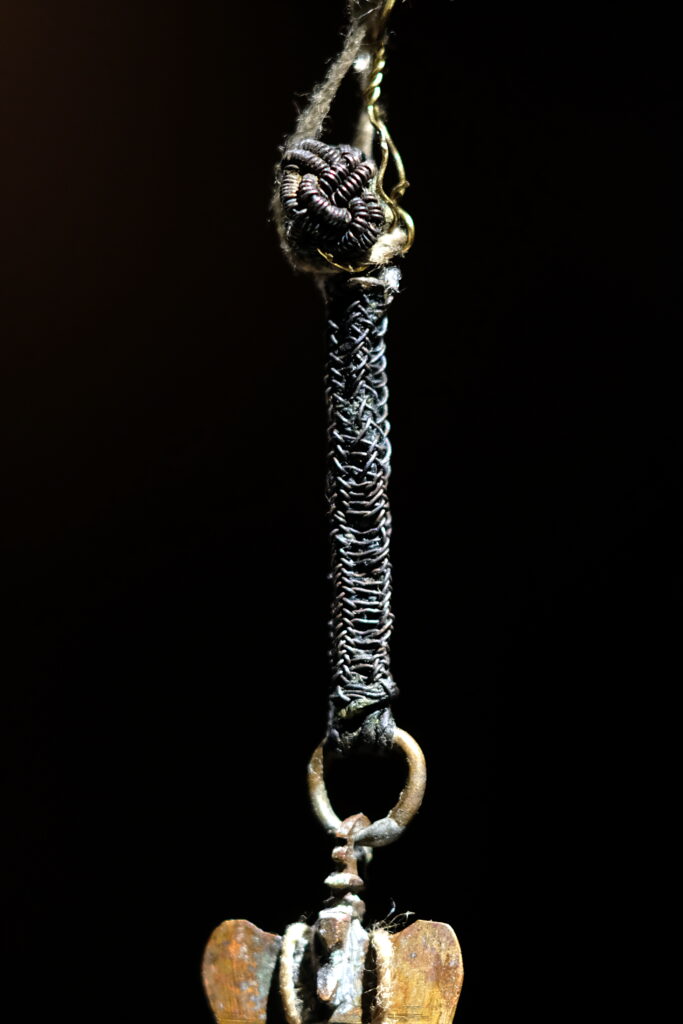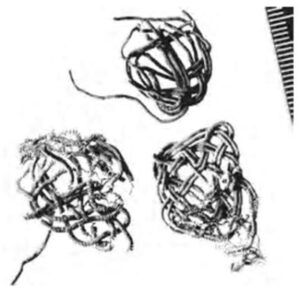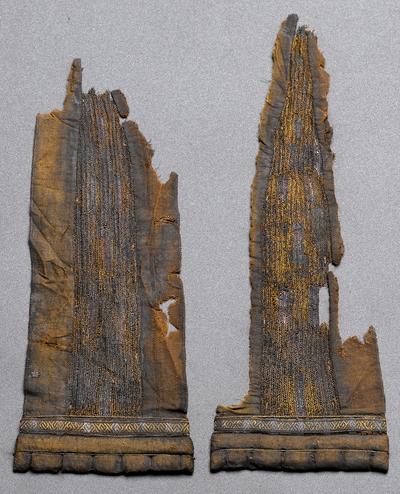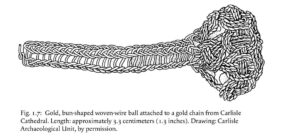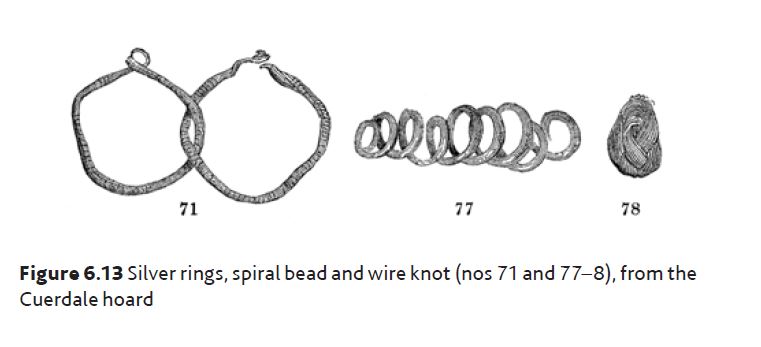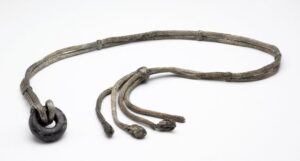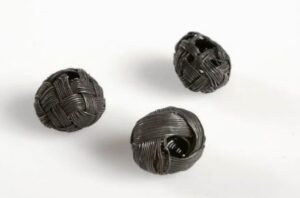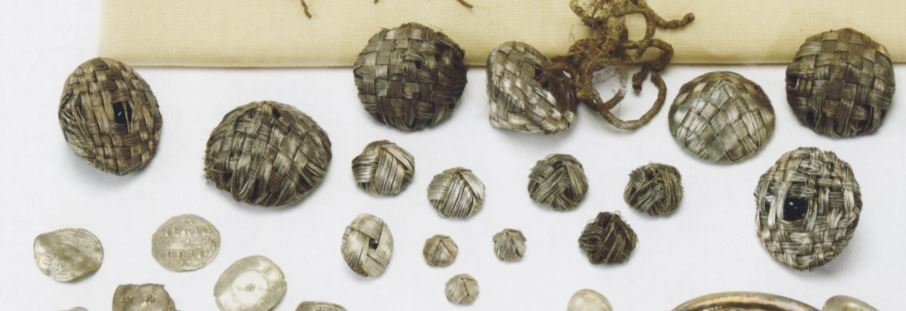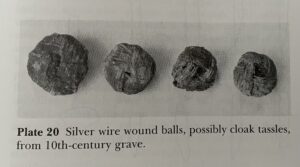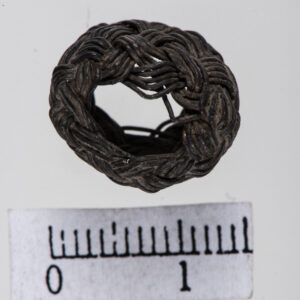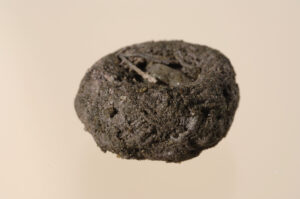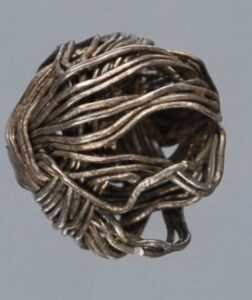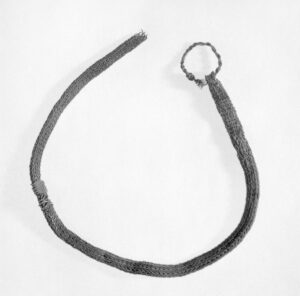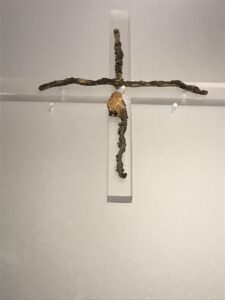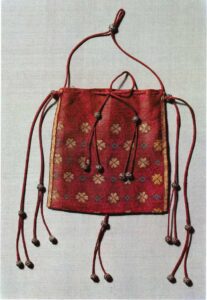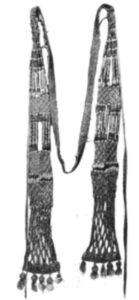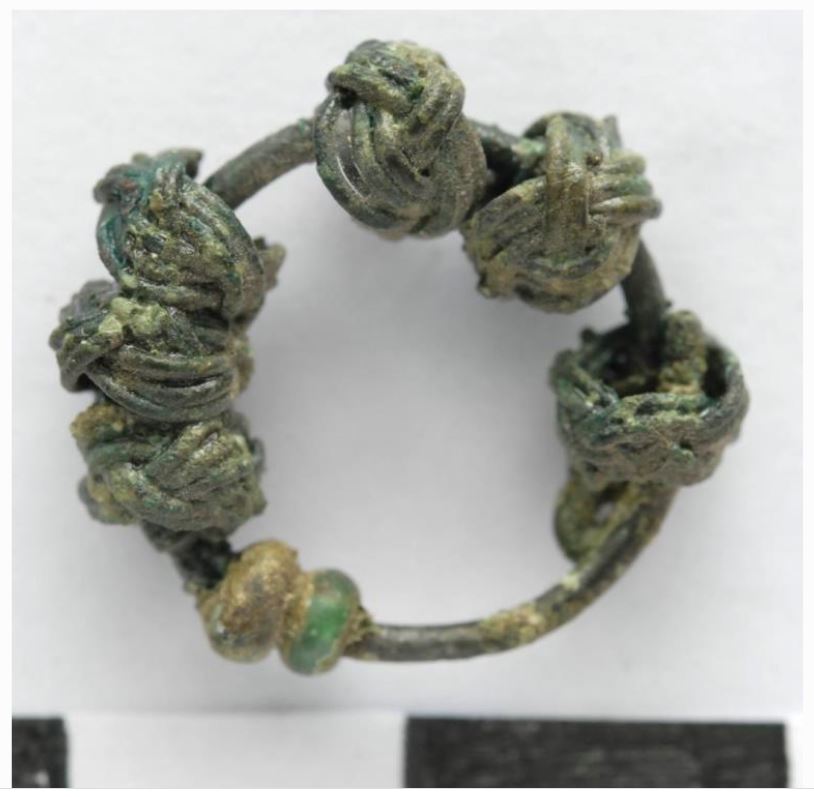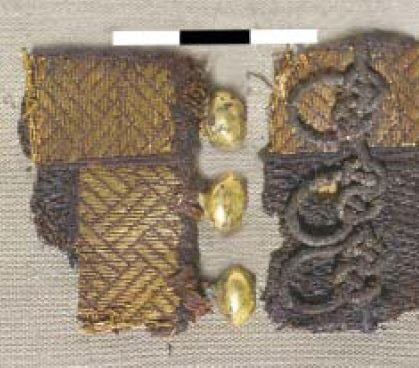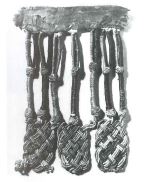This is a compilation of the posaments and other wire trimmings from outside the Birka area. These items are also displayed on map of the finds to better illustrate their overall distribution and the relative distribution of sub-types. See the Posament Bibliography for complete citations. Please let me know if you know of any other posaments from outside Birka or have a better source of information for any of these!
Posaments Before 1000CE:
Denmark, Haithabu (Hedeby) – 8th-11th century CE (Inga Hägg – Die Textilfunde Siedlung und Graeber Haithabu)
- Unnumbered grave – stone wrapped with spiral silver wire (not pictured)
- Unnumbered grave – spiral silver ring
- Grave 188/1960 – two spiral silver rings (one intact, one in pieces and not pictured) and a knife handle decorated with spiral silver wire
- Grave 204/1960 – knife or awl handle wrapped with spiral silver (not pictured
- Grave 27/1963 – spiral silver ornaments, not pictured or further described (“Zierate aus gezogenem Spiralsilberdraht (Durchmesser 0.25 mm)”
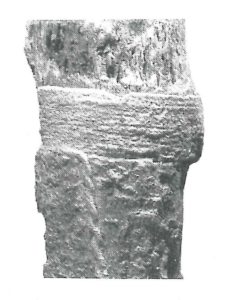
Hedeby 188-1960 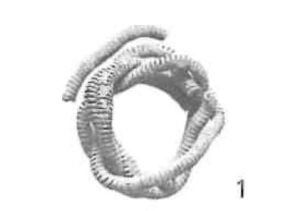
Hedeby 188-1960 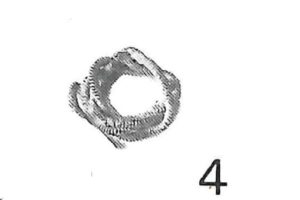
Hedeby unnumbered grave
Denmark, Ladby – c925CE (Knud Thorvildsen – Ladby-Skibet – pages 80-81. Sorensen, A – Ladby: A Danish Ship-Grave from the Viking Age – pages 74-76)
- Strap end (Item 392)
- Knot (Item 81)
- Knot (Item 501)
- Multiple Stickerei (related ornaments also found in Birka, but not posaments)
England, York, St. Mary Bishophill Senior – early 10th Century CE (Hall, R. A. “A silver appliqué from St. Mary Bishophill Senior, York.” (1998).)
- Rectangular spangle of drawn silver wire
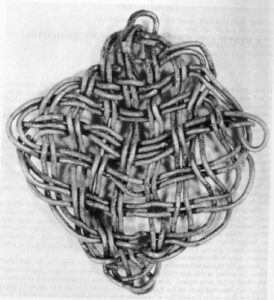
Gotland – The Gotlandic posaments are treated separately from the Swedish and Birka posaments because they are actually distinct both in form and location from the Birka collection. They follow a different “grammar” than the Birka posaments. Whereas the Birks posaments use two strands per line and include braids and knots, the Gotlandic posaments more commonly use a single strand per line and are limited to braids. (Stenberger, Mårten. Das Gräberfeld bei Ihre im Kirchspiel Hellvi auf Gotland Acta Arch 32 1961; Stenberger, Mårten. Die Wikingerzeit Gotlands IV; Stenberger, Mårten. Die Wikingerzeit Gotlands I; Sörling. Fornvännen 34.)
- Gotland, Halla Broe A – Spiral silver braid – This appears to be a three part braid of spiral silver, pictured from the side, but the photo and the text are not perfectly clear. It is possible that this is three beaded wires that have been braided or twisted as they may be inflexible. (Image Bertha Amaya SHM 2006-11-29 Creative Commons Erkännande 2.5 Sverige)
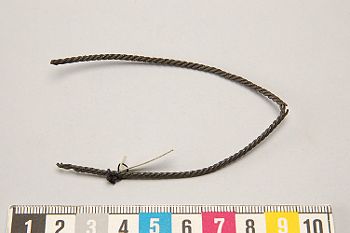
- Gotland, Helvi Grave 212 (Stenberger #111) – Silver braid – single lines of spiral silver wire. Grave includes multiple pieces in two widths, so probably represents two different braids. (Die Wikingerzeit Gotlands IV page 402, Die Wikingerzeit Gotlands III:1 page 362, Gotlands museum).
- Gotland, Helvi Grave 215 (Stenberger #110) – Fragments of spiral silver, described as a broad band in DWG III:1 – (Die Wikingerzeit Gotlands IV page 403, Die Wikingerzeit Gotlands III:1 page 362) (not pictured)
- Gotland, Helvi Grave 494 (Stenberger #84) – Three P24 sliding knots in spiral silver (Die Wikingerzeit Gotlands III:1 page 362, Gotlands museum)
- Gotland, Helvi Grave 497 (Stenberger #108) – Silver braid and “pearls” – the braids are probably Stickerei but the “pearls” are likely posament knots. In DWG III:1, a silver spiral “knot” is described as belonging to this grave. (Die Wikingerzeit Gotlands IV, Die Wikingerzeit Gotlands III:1 page 362, and Gotlands museum website) (not pictured)
- Gotland, Helvi Grave 504 (Stenberger #112) – Spiral silver braids – the fragments come in two distinct widths and so likely represent two separate bands. (Die Wikingerzeit Gotlands IV page 435, Die Wikingerzeit Gotlands III:1 page 362, Gotlands museum)
- Gotland, Helvi Grave 504 (Stenberger #112) – Spiral silver knot or ring – Need to locate picture to verify that the text is referring to the hot mess at bottom right. A doubled line of spiral wire forms knots and is jumbled together with some length of drawn wire. (Die Wikingerzeit Gotlands IV page 435, Die Wikingerzeit Gotlands III:1 page 362, and Gotlands museum website)

Grave 212 
Grave 494 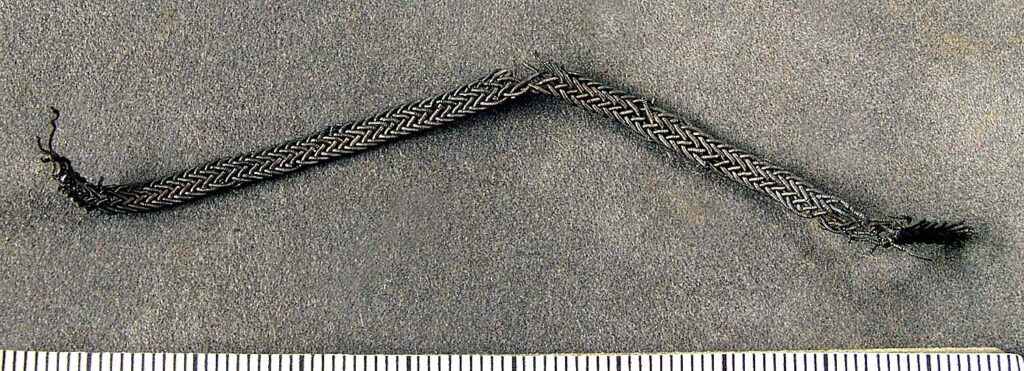
Grave 504 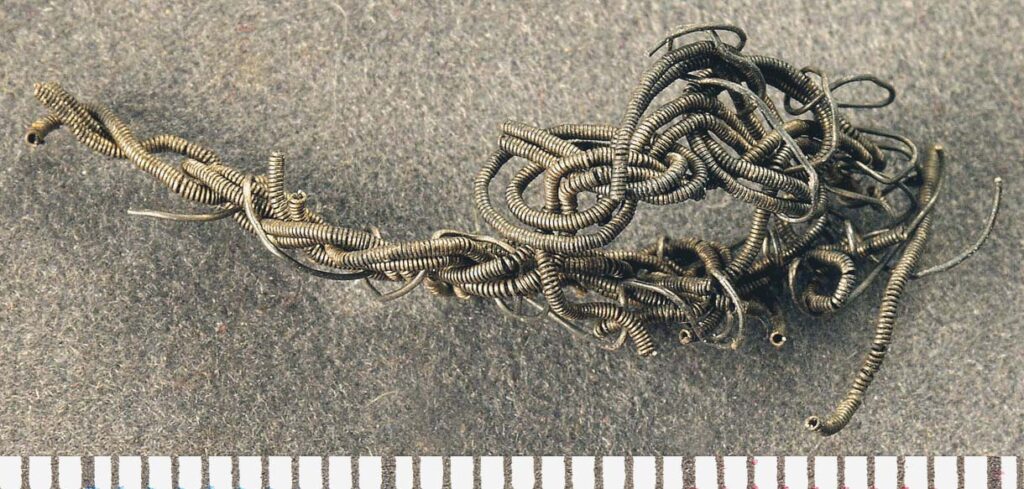
Grave 504
- Gotland, Källunge Church – mass of silver spiral threads in a box – original form unclear. Found on the Gotlands museum website, but I would love any further information anyone might have!

- Gotland, Slite Torg – Fragments of spiral silver – too fragmentary to identify securely, but possibly a sliding knot – (Die Wikingerzeit Gotlands IV page 573)
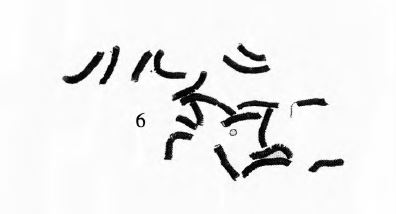
Slite Torg
- Gotland, Väskinde – Spiral silver braid – While standard posament work can be impressive, this braid is legit INSANE. Silver wire of a 0.05mm diameter is wound around a silk thread to form a 0.2mm diameter SPIRAL which is then braided/woven in a complicated technique requiring 41 ends. CRAZY. Probably my favorite of the Gotland finds. (Lundgren, 1975; Nylén 1975)
Ireland, Garron Point – Unfortunately, this hoard has been lost and the only evidence is a 1905 photograph. One of the items in the hoard is a silver woven flail with five surviving knots. There has been damage to the chain, so it is possible that there were originally more knots. Interestingly, at least the large knot is a combination of drawn and spiral silver wires. It is possible that two of the smaller knots are also made of hybrid wires, but it is difficult to tell from the current image and a better quality copy of the image has been requested. Large knot – P24 (spiral-drawn-spiral); Knot at center top and knot right middle – P24 (possible blend of spiral and drawn); two knots at top right – P23 (spiral-spiral). (Graham-Campbell – The Cuerdale Hoard p 121)
Ireland, Kilkenny – A bundle of fabric found in Dunmore Cave included a collection of conical silver buttons (see below for related non-posament items). One of the buttons had a fragment of spiral silver thread attached. Less frequently pictured or discussed is the spiral thread “fringe” which appears to be a braid of spiral posament threads. I am currently seeking additional information about this piece. (National Museum of Ireland, Patrick F. Wallace, and Raghnall O’Floinn. Treasures of the National Museum of Ireland: Irish Antiquities. Dublin: Gill & Macmillan, 2002.; Halpin, Andy. “The Dunmore Hoard.” Irish Arts Review (2008).)
Norway, Bergen – Remains of a wire-woven chain and clasp(?) with a wire ring. The wire ring has two strands in each line, each strand made of two wires twisted together. Theoretically, there would have been one on each end of the chain at minimum. This was found in an online database, so any additional information would be most welcome. Image from Unimus, photo by Ann-Mari Olsen – CC BY SA.
Norway, Huseby – One complete and one badly damaged sliding ring on a wire woven chain from a 9th century female grave. Two strands in each line, each strand made of two wires twisted together. (Ystgaard, Ingrid, and Ragnar Magnus Vennatrø. “Våpengrav fra vikingtid på Mannsfjellet, Olstad, Skaun kommune, Sør-Trøndelag.” NTNU Vitenskapsmuseet arkeologisk rapport (2016). Bakka, E. (1962). Oldsamlingens tilvekst 1960: Vol. 1960 no. 4 (p.26). Universitetsforlaget.) Image from Unimus – Ole Bjorn Pederson CC BY-SA
Norway, Ness – A knot similar to P17 but with a structure like the rectangular posament from Ladby that incorporated twisted wires as well as the spiral wires. The piece appears to be sewn between two pieces of a tabby silk (~50 threads/cm), similar to the end of the posament on the Chinese silk in Birka (Bj944). The posament was found to the left of the deceased’s head, roughly between the left ear and shoulder, but the grave had been significantly disturbed. This grave also contained about eight small pieces of loose spiral wire and spiral wire embedded in an additional scrap of silk that may represent (an?) additional ~P17(s?) but no additional twisted silver wires are reported, so the fragments may represent (a) completely different posament(s) as well. Also see below for a wire ball from the same grave. (Lund, Thomas. En analyse av båtgraver fra jernalder i Nord-Norge. MS thesis. UiT Norges arktiske universitet, 2018; Personal communications with museum 2/26/2021.) Image by Cora Oschmann.
Norway, Sanddal – A wire-woven chain with sliding knots comes from a female boat grave. The three decorative knots are formed from two wires twisted together into a strand and then braided into a ring with two strands in each line. This construction of a wire-weaving chain girded by twisted wire rings seems particularly common in Norway but is similar to the Trewhiddle Hoard flail and the Garron Point chain. (Bakka, E. (1962). Oldsamlingens tilvekst 1960: Vol. 1960 no. 4 (p.26-30). Universitetsforlaget. (Graham-Campbell, J. 2011. The Cuerdale Hoard and Related Viking-age Silver and Gold from Britain and Ireland in the British Museum, London: British Museum, 123).)
Norway, Suldal – Remains of a wire-woven chain and two end caps with a wire ring. The wire ring is made of drawn wire with three strands in each line. Theoretically, there would have been one on each end of the chain at minimum. This was found in an online database, so any additional information would be most welcome. Image from Unimus, photo by Svein Skare – CC BY SA.
Norway, Vangsnes – A drawn gold wire P4 band of about 23cm in 3 pieces. Please note that the photos are black and white but the museum website specifies that this is a gold wire posament. (https://www.unimus.no/portal/#/photos/241d9e59-b5f7-4bc8-b016-51bb0646cc06) Photo: Ann-Mari Olsen, CC BY-SA.

Poland, Świelubie – An interesting gravefield in Western Pomerania includes a collection of burials of people from the Mälaren valley. Most of the Scandinavians buried in this are are Danish, but there appears to have been a Swedish population living near Bardy, but the reason for this outpost is unclear. The graves include numerous items that are stylistically characteristic of Birka and include two sliding knot posaments in a female cremation grave. ((Polish) Krzewicka, Alicja. “Wczesnośredniowieczne znaleziska w typie skandynawskim z terenu Polski.” (2013). Image from figure 39. Also (with Polish and English content): Duczko, W. (2020). Scandinavians on the banks of the Parsęta river: Viking graves in the cemetery at Świelubie in Western Pomerania. Archeologia Polski, 65, 131-187. Retrieved from https://journals.iaepan.pl/apol/article/view/APol65.2020.004)
Russia, Gnezdovo – A single example of a strap finial like P22 on the remnant of a silk ribbon. This posament does not have a ring at the base, but it is not clear if no ring was present or if the ring has been damaged and lost. (Орфинская О.В. Текстиль Гнёздовского комплекса, К-97.10. Позумент из канители с шёлковой тканью — самит (рис. 40).)
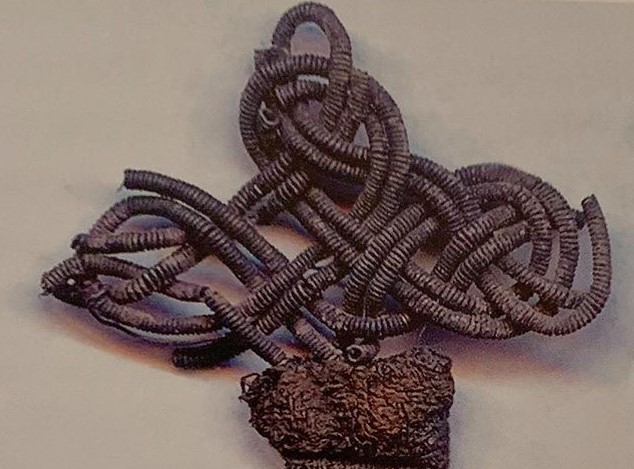
Scotland, Ballinaby – A tripled knot of twisted silver wire appears at either end of the woven chain. These knots are very similar to P25. Graham-Campbell describes the knots as being a triple plait with two strands in each line and two wires twisted for each strand (a total of 12 wires), but I think it is more likely to be two continuous wires twisted together and then formed into a sliding knot. The chain is trichinopoly (Scotland in Pagan times, pages 27-29, figure 23 – top shows full piece, bottom shows detail of knot ending; Graham-Campbell, J. 1995. The Viking-Age Gold and Silver of Scotland (AD 850-1100), Edinburgh: National Museums of Scotland, page 30, page 156, figure 62, plate 74b; Scotland in Pagan times, pages 27-29?, figure 23)
Sweden – There are several places in Sweden outside of Birka that have posament work. Please also see the section on Gotland. (Gotland is treated separately from the other non-Birka Swedish materials because there are stylistic differences between the posament work found on the mainland and those found on Gotland.)
- Sweden, Adelsö – Very close to Birka and probably could be considered as part of the main collection. (Rydh, H. Forhistoriska undersokningar pa Adelso.
- Knot (grave 9)
- Three gold crosses like P16 but very fine wire (Skopintull (Primärgrav), Hovgården or Ormknös)
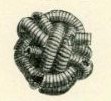
- Sweden, Gamla Uppsala – A single sliding knot was found at Gamla Uppsala. There is some question about its origin as it was initially reported as coming from the Eastern mound in the main complex, but that would place it in the Vendel Period, as early as 500-600 CE, which is improbably early based on the other posament finds. Because of the poor record-keeping at the time of the excavation, it is possible that the knot came from another smaller excavation of a nearby Viking Age mound but exactly which is unclear. The knot itself is a spiral silver P24 with three lines and no core present. It is in a damaged but recognizable state. (Personal photo. Larsson – Klad Krigare p81-87.)
- Sweden, Huddinge – Near Stockholm – photos and info from SHM website.
- Fragments of a P9 band
- Six sliding knots like P23 or P24
- Sweden, Järfälla – Per the SHM online catalogue, a flat, twisted silver posament. No further details or images available at this time.
- Sweden, Småland – There is some question about the number and identity of the posaments from Småland. Geijer cites two posaments, an end knot P26 and a sliding knot P24 (Birka III, p 104). The report of the find on SHM call them “knut, flätad av silvertrad; pärla, flätad av silvertrad” which sounds like it may match Geijer’s description. The excavation sketches, however, show a finial-type posament, similar to a P22 without a crowning ring, and a solid end knot like a P26. Of particular interest is the sketch of the possible P22 which appears to shows a construction for the finial where the doubled line goes around twice to form both the inner and outer loops of the posament but no ends are clearly shown. The associated text calls them “Knut, flätad av silver” and “Pärla, flätad av silver” and makes no mention of a ring. On the third hand, the (admittedly very poor) photos of the find seem to support the presence of a P22 but show a structure with a clear hole in the middle, implying a P24 or possibly a crowning ring from the P22. The “knut” is badly damaged, but the small loops that exist in places argue against it being a degraded P26. Reviewing Birka III (page 104) under P26 it reads “Der Knoten P 23, ebenfalls in Spiralsilber ausgeführt, kommt in den Gräbern 976 und 181 vor. Rings um den Ansatz von mehreren Gehängen und Abschlusszieraten finden sich gleichartig ausgeführte Ringe (P 21-22, St 22). Aus einem Brandgrab aus Krsp. Aringsäs, Småland (S. H. M. Inv. Nr. 19803: 5) stammt ein Endknoten gleich P 26 und ein Gleitknoten gleich P 24, beide aus Silberdraht.” (The knot P23, also made of spiral silver, occurs in graves 976 and 181. Rings of the same design can be found around the attachment of several pendants and finishing decorations (P21-22, St 22). From a cremation grave from Krsp. Aringsäs, Småland (S. H. M. Inv. No. 19803: 5) has an end knot equal to P26 and a sliding knot equal to P24, both made of silver wire.) It seems strange to be mentioning P23, P21, and P22 here, under P26. With the evidence from the drawing and the poor photograph I wonder whether P26 isn’t an error for P22, particularly since Geijer calls the first one an “end knot” and she groups P26 with P23, P24, and P24, the “sliding knots.” On the other hand, the drawing of the finds shows a fairly distinctly tight ball that looks like a textbook P26. Therefore, it is difficult to definitively say how many posaments exist.
- One posament – a P22 with a ring (based on the photograph)
- This requires that Birka III and the drawing being in error about the “pärla”/P26
- Two posaments – a P26 (based on the drawing and Birka III description but no longer found in SHM) and a P22 with a ring (based on the photograph)
- This requires that Geijer have missed the loop portion of the P22 or that the text be unclear, the P26 be lost, and the ring not be mentioned in the excavation report.
- Two posaments – a P22 withOUT a ring (based on the photo and the excavation report) and a P24 ring (based on the photo)
- This requires that Birka III have an error (P26 when it meant P22) and that the excavation report has drawn the ring like a bead/P26
- Two posaments – badly damaged P26 (as provided for in Birka III but not clearly recognizable as such now) and a P24
- The P22-like pieces in the photo are not consistent with a smashed P26. If they are meant to be the P24, then the ring in the photograph would have to be a much-relaxed P26, which is unlikely. This is also at odds with the illustration, which shows the non-ring pieces and knot.
- Three posaments – a P26 (from the illustration and Birka III), a P22 withOUT a ring (from the illustration and the photo), and a P24 ( (from the illustration, photo, and Birka III).
- This requires that Geijer have missed the loop portion of the P22 or that the text be unclear, the P26 be lost, and the ring not be mentioned in the excavation report, and the ring and P22-like piece be considered separate.
- One posament – a P22 with a ring (based on the photograph)
- While many of the posaments have similar structure and, when damaged, can appear quite alike, I think it unlikely that tight ball in the illustration has become either of the items pictured in the SHM files. For the purposed of my spreadsheet, I cam considering there to be three separate posaments (P22, P24, and P26) with the understanding that P24 may in fact be a part of P22. (See Birka III and the SHM record.)
- Sweden, Söderby, Lovö – One damaged sliding ring of spiral silver, probably a P24. (SHM website – image by Marie Lindström SHM 2017-09-27)
- Sweden, Valsgärde båtgrav 12 – A total of 10 posament sliding rings in addition to several pieces of wire weaving or Ösenstich.
- Textiles – Five rings come from the textile remains and include two P23s (59 and 71), two P24s (63 and 65), and irregular knot similar to a P24 (70). Some of these have a yellow, Z-spun, plant-based core (tested by C. Lindblom). All of the knots except the irregular number 70 are associated textiles silk samite ribbons or cords, some of which are yellow-brown and some are carbonized. (Annika Larsson, Kladd Krigare. Other images and knot info from C. Lindblom, I doden Kladd)
- Scales – Five additional rings are associated with the scales. These do not appear to have been published anywhere and while I have seen them in person and have examined better photographs from the Gustavianum, those images are not available for publication. The photo below is courtesy David Eyestone from the exhibition “The Vikings Begin” when it visited Minneapolis, MN. The sliding rings on the scales include one spiral silver P24, two double-line drawn twisted silver P25s, and two triple-line drawn twisted silver P25s. The P25s are clumsily made and the twist of the component lines is inconsistent. These rings are associated with the cords supporting the scale’s pans, including the tops suspension cord which acts as a core to a single wire-weave. The sliding knots are arranged with the spiral silver P24 at the top, one double P25 at the top of the cord attached to the balance arm, and the triple knots just above where each cord splits into three to hold the balance pans.
- Sweden, Valsgärde båtgrav 15 – P25-type sliding knot with three working lines of two twisted drawn silver wires each. I have not seen a publication of this find either. Many thanks to Karolina Pallin for the image.
Ukraine, Shestovitsy (Shestovica) – The cemetery at Shestovica has strong Scandinavian ties, so many of the finds may be imports or heirlooms rather than locally produced items. Mound 110 (10th century) produced four spiral silver spangles that appear to be similar to P19. (Drevnerusskie pamyatniki Shestovitsy, pg 221, 229, Plate XXXII #9 & #10)
Not Posaments, but Contemporary Related or Similar Techniques:
This is a list of items of interest that I have found during my quest to catalogue the posaments. It contains items that are similar to or often confused for posament work because of similar techniques and dating. This is not a complete and exhaustive list and may not include photos or citations for all entries. Please contact me for details of any item of interest.
Denmark, Mammen – the “pennants” have a middle section of twined threads that is similar to stickerei but is made of a lahn thread, not solid wires. (Mammen: Grav, Kunst Og Samfrund i Vikingetid)
England, Branston and Mere Lincolnshire and others (see below) – There is a collection of woven wire rings found in Britain with an uncertain status. The Finds Recording Guide for the Portable Antiquities Scheme lists “Plaited Metal Rings” as having potential dates from the early middle ages through the late 19th century and recommends recording with a date of “unknown.” Graham-Campbell considers them to be firmly a medieval and so potentially appropriate to include as a contemporary related find. (“This metal-detected single find, which clearly belongs to this group of material, was dated ‘?19th century’, during the Treasure process (Treasure Annual Report 2003, no 306).”(Graham-Campbell, J. 2011.) However, there are extant examples of early modern swords and 19th century hunting whips and other equipment with very similar rings, so I am not convinced that a post-medieval date can be ruled out for all of the finds, particularly those found as stray finds without a firm context. The Finds Reporting Guide states that there are at least 20 potential wire rings that could be included in this group. I have tried to identify as many as I can and these are listed below. (Graham-Campbell, J. 2011. The Cuerdale Hoard and Related Viking-age Silver and Gold from Britain and Ireland in the British Museum, London: British Museum, 123, page 132 note 27); Treasure Annual Report 2003, no 306.; Finds Reporting Guide – accessed 3/25/2021) Image from Treasure Annual Report 2003, figure 306.
- Potential wire rings from the Portable Antiquities Scheme, of debatable date. As these are generally of drawn wire and of debatable period, I am considering them provisionally related but, other than the Branston and Mere example, they are not on the map nor on the spreadsheet. The earliest period is noted below, but most of these should probably be considered “unknown.” The items marked as being braided rings are the most likely to be potentially related. The wider “barrels” are more dissimilar from the posaments, wire rings, and wire balls. Several of the finds are not pictured and so identification is difficult or impossible.
- BUC-5C624A – Stone with Bishopstone and Hartwell – Post-Medieval – grey metal – twisted wires in seven strands per line forming a long braided barrel
- CAMHER-DA6395 – Meldreth – Post-Medieval – seven strands per line forming a short braided barrel
- DENO-F7EC2C – Eyam – Unknown – silver – 5-7? drawn strands in a long braided barrel (currently smashed flat)
- DUR-C937C1 – Sherrif Hutton – silver – 6 strands in a braided ring
- HAMP1397 – Hampshire Thruxton – Post-Medieval – silver – 4 twisted strands in a braided ring
- IOW-05025E – Isle of Wight – Modern – 6 strands in a three plait braided ring
- IOW-8493A3 – Totland Parish – Unknown – 8 strands per line forming a long braided barrel
- KENT-055A74 -Dover – Early Medieval – silver – 5? drawn strands in a braided ring
- KENT-5B98E3 – Darenth – Early Medieval – not pictured “Silver wire interlaced ring”
- KENT-A512A4 – Chislet – Early Medieval – silver – six strands forming a braided barrel
- LANCUM-53532A – Mitton – Post Medieval – many very fine wires in each part of a three part braided ring
- LANCUM-D87896 – Halton – Modern – many wires in each part of a three part braided ring
- LIN-C29D8B – Ancaster – Unknown – silver – 3 wires twisted together and then braided into a three plait ring with four strands per line
- NMS-54D4F7 – Shipdham – Post-Medieval – silver – 2 strands in a braided ring
- PAS-DC12AF – Branston and Mere – probably 19th century – silver – 6 drawn strands in a short braided barrel
- RAH1155 – Northhamptonshire Old Stratford – Unknown- silver – Not pictured – “Ring of plaited silver wire – 3 strand plaits, 2 of 4 wires, 1 of 5.”
- SF-64D062 – Coddenham – Post-Medieval – silver – 6 strands (fewer in places) – in a braided ring
- SF-DF1B38 – Preston St Mary – Modern – silver – 8 strands in each line of a three plait braided ring
- SF-ECD665 – Buxhall – Postmedieval – silver – five strand three plait braid
- SWYOR-4395A0 – Post-Medieval – silver – small woven ball, 5-6 strands/line – likely to be modern
- WMID516 – Staffordshire Hammerwich – Modern – silver? – Not pictured – “A multiple ?silver wire plaited loop. Each swath of wire consists of circa 9 strands of rectangular sectioned wire. Some strands are broken.”
- WMID553 – Hereford and Worcester Great Witley- Unknown – silver – Not pictured “Multiple silver threads plaited together create the ring. Each braid has seven strips of silver wire. There are three braids which are plaited together.”
- WMID-9F9082 – Ilam CP – Modern – silver – twisted or plaited, but not like the posaments, included for completeness only.
England, Carlisle – Woven ball and cord made of gold wire. The pattern on the “ball” is made using three strands per line, each strand being two wires that are twisted together. The ball is made up of interlocking circles held together with a horizontal line which is similar to the posaments P12 and P15 but which is further ornamented with smaller circles at each junction. A portion of a wire chain protrudes from the bottom. While the interlocking circles is reminiscent of posament work, the structure (three lines, twisted wires instead of spiral wires, blending of large and small knots) is not and so this is not considered a posament but is definitely a related item of interest. (Whitfield, N. 2006. Dress and accessories in the Early Irish Tale ‘The Wooing of Becfhola’ in R. Netherton and G. R. Owen-Crocker (eds) Medieval Clothing and Textiles 2, 1–34, Woodbridge: Boydell, page 30, Figure 1,7 (below); Caroline Paterson and Dominic Tweddle, ‘Gold and Silver’ in Mike Mccarthy, Marion Archibald, Colleen Batey, Catherine Batt, Catherine Brooks, Jo Buckberry, John Cherry, Adrian Evans, Geoffrey Gaunt, Graham Keevill, Ceilidh Lerwick, Janet Montgomery, Patrick Ottaway, Caroline Paterson, Elizabeth Pirie, Penelope Walton Rogers, David Shotter, Jacqueline Towers & Dominic Tweddle (2014) A Post-Roman Sequence at Carlisle Cathedral, Archaeological Journal, 171:1, 185-257 DOI: 10.1080/00665983.2014.11078266 Pages 208-209, Illustration 15)
England, Cuerdale Hoard – small woven silver bead of six drawn silver strands per line. #78 in image below. (Graham-Campbell, James, and Barry Ager. The Cuerdale hoard and related Viking-Age silver and gold from Britain and Ireland in the British Museum. British Museum, 2011. page 123, figure 6.13 (page 122))
England, Ingleby – c. 880-900CE – Ösenstich – Posnansky, M (Crowfoot, E) – The Pagan-Danish Barrow Cemetery at Heath Wood, Ingleby 1955
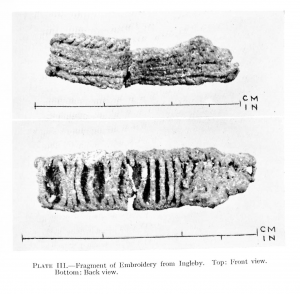
England, Trewhiddle Scourge – The trichinopoly chain features several posament-related structures. At the slender ends, the chain terminates in small silver wire balls. Three survive, but a fourth was present in early photographs. The chain is banded with five drawn wire sliding knots, each with four strands per line. The location where the chain splits into four is bound with one large sliding knot with nine strands per line. While the wire balls clearly fall into the “related but not posament category,” I am also categorizing all the sliding knots as related and not proper posament work because they differ from the Birka posaments in a few key ways: 1) They are made of untwisted drawn silver wire whereas the Birka sliding knots are either twisted wire or spiral wire; 2) The sliding knots are all made of more than three lines whereas the posament examples are two or three lines; 3) the knots are more appropriately called Turks Head Knots, since they do not in fact slide.; and 4) These knots are on a wholly metal item and not associated with a textile (either fabric or cord) or leather item. That said, they do bear a strong resemblance to the posaments and arguments could be made for their inclusion. The early cate of the hoard (c868CE) would make these very early examples of posament work if they were included.
Germany, Ausburg – Girdle of St. Witgarius – fringe and balls constructed using lahn, not solid wires. (The Techniques of Tabletweaving, Peter Collingwood, p 242-244, plate 197 and 198)
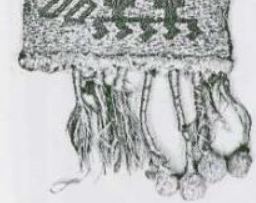
Germany – “Byzantine” bag – Previously identified as Byzantine, this is now recognized as 10th century German. There are several flat knotted elements that look very much like posaments, but appear to be made of lahn wound around a core. Also note the braided frame. I have been able to view high-resolution images from the museum but have not examined this piece in person and would love a report from anyone who has. (Museum page. Mittelalter Kunst und Kultur von der Spatantike bis zum 5. Jabrbundert Verlag des Germanischen Nationalmuseums Nurnberg, page 95.)
Gotland
This is not an exhaustive list of the stickerei in Gotland – there are A LOT of examples – these are just the ones that came up when looking for posaments.
Contact me for additional details. I will hope to complete this at some point, but right now it is not the topic of focus.
- Halla Broe B – Silver band – Stickerei – Broe Grab B/1899, SHM 11106:2. Interestingly, tis was found near a dog’s skull and was interpreted as belonging to a dog collar. (Die Wikingerzeit Gotlands IV-1 – p 328 “Ein ausgestreckt unter dem Hundeschadel liegendes Band aus geflochtenem Silberdraht wurde von Hansson als Beschlag eines Hundehalsbandes angesprochen.” “A band of braided silver wire lying stretched out under the dog’s skull was referred to by Hansson as fitting a dog collar.”) Image Bertha Amaya SHM 2006-11-20 Creative Commons Erkännande 2.5 Sverige.
- Halla Broe B – Edge wire – Ösenstich – Broe Grab B/1899, SHM 11106:2 Image Bertha Amaya SHM 2006-11-20 Creative Commons Erkännande 2.5 Sverige

Stickerei band 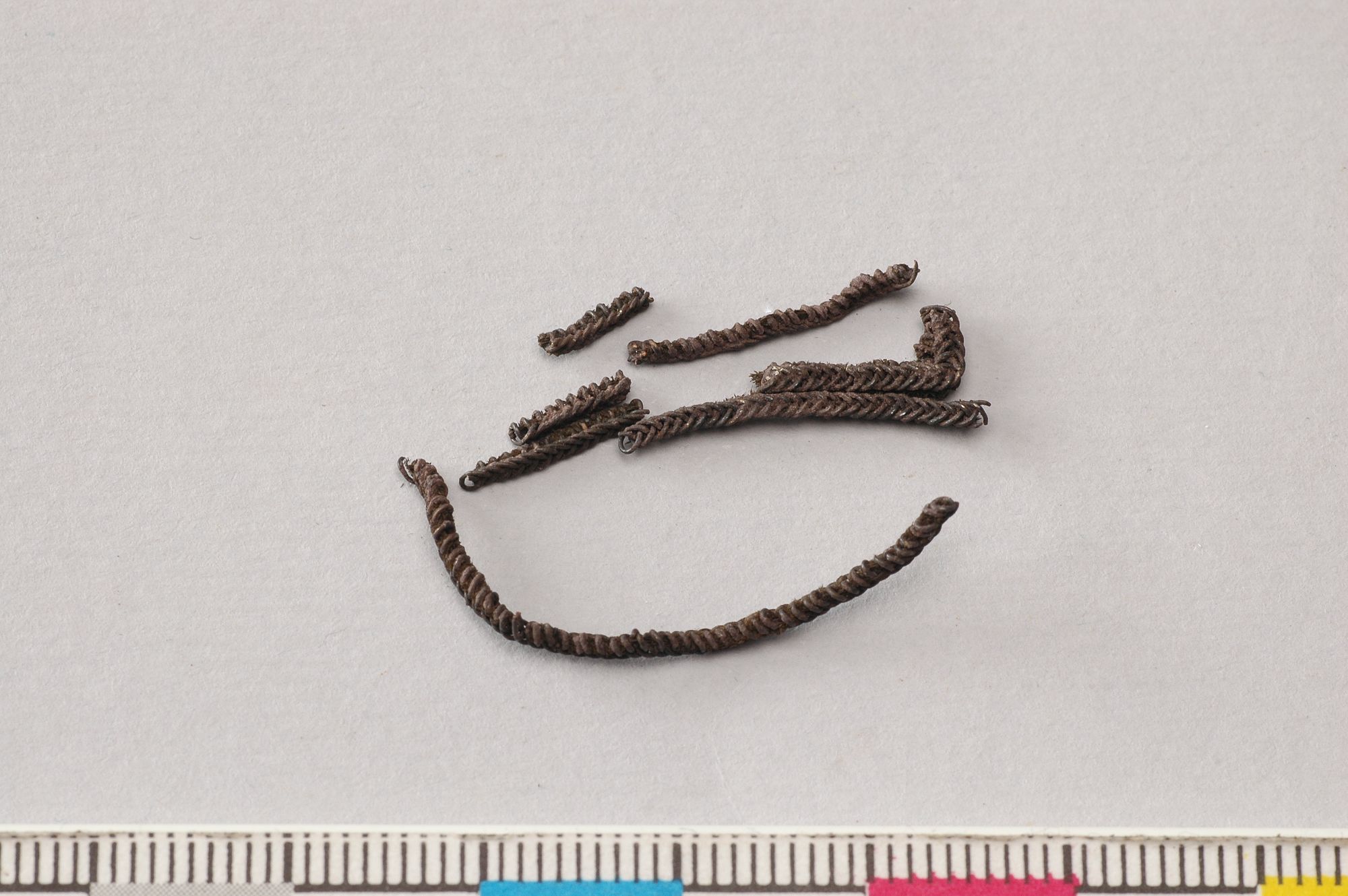
Broa Grab B Edge wire
- Austers, Hangvar – Silver stickerei band, similar to St 15 – drawn silver wire – Austers, Ksp. Hangvar SHM 2309 – (Image credits: Left: Christer Åhlin SHM 2011-12-19 Creative Commons Erkännande 2.5 Sverige. See also: Die Wikingerzeit Gotlands II, Page 285)
- Endre, Kvie – Silver stickerei band, similar to St 15 – drawn silver wire – Endre, Kvie, SHM 5725 – (Die Wikingerzeit Gotlands IV: 1, Page 144, image Die Wikingerzeit Gotlands II, Page 285))

- Helvi Grave 497 (Stenberger #108) – Silver braid and “pearls” – the braids are probably Stickerei but the “pearls” are likely posament knots. (Die Wikingerzeit Gotlands IV, Die Wikingerzeit Gotlands III:1 page 362, and Gotlands museum website)
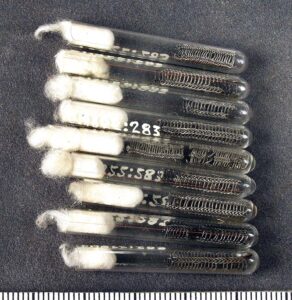
- Othem (Slite) – SHM 15752 – Ösenstich (Die Wikingerzeit Gotlands I figure 255:6)
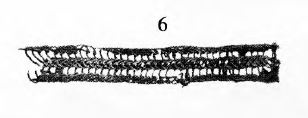
- Sandgarde – SHM 22005:4 – three pieces of drawn silver wire ribbon (and a silver brocaded tablet woven band). Described as fragments of two different types of Ösenstich, only one pictured. (DWGotlands 1 figure 264:1)

- Väskinde – Stickerei from an equestrian grave , found around the shoulder and upper arm, possible as decoration on a short sleeved tunic. (Lundgren, 1975) Photo: Bertha Amaya SHM 2007-01-09 Creative Commons Erkännande 2.5 Sverige

- Visby – SHM 3910 – Ribbon in Ösenstich (3 chains) made of solid wire (Geijer 1938, p. 114, St 15e) Photo: Elisabet Pettersson SHM 2006-12-22 Creative Commons Erkännande 2.5 Sverige
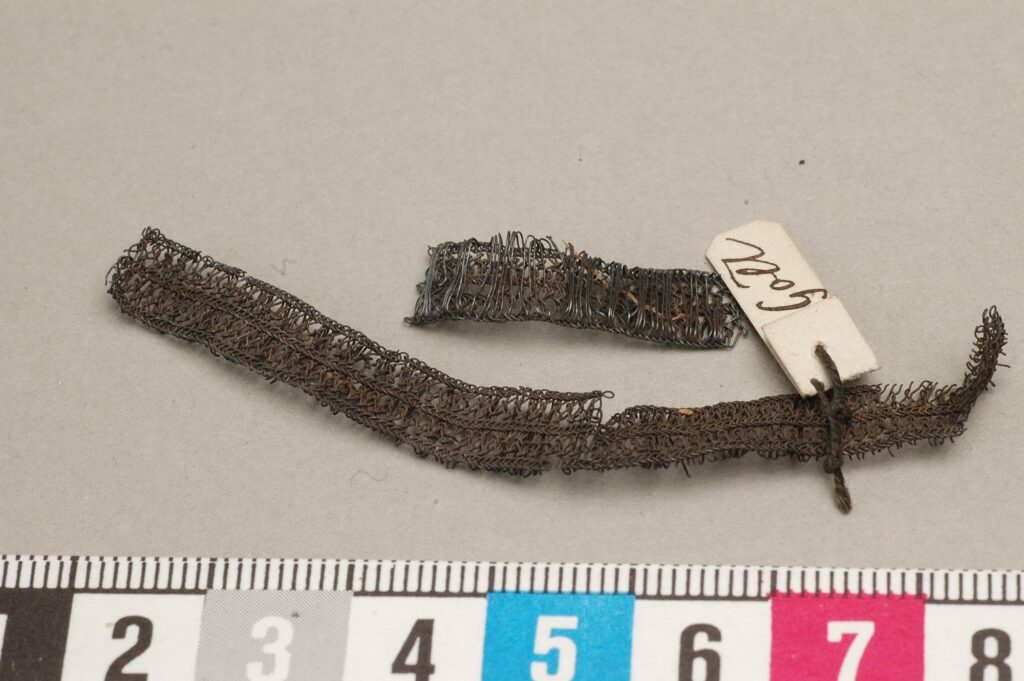
Iceland, Kápu við Ƿórsmörk – Three silver wire balls/buttons and one gold ring. All from drawn wires with 9 (silver) or 10 (gold) strands in each line. They are 9-10th century. Two of the silver balls are clearly woven, not braided and so are not posaments. The third silver ball and the gold ring have a braided structure and so are very posament-adjacent, but the drawn wires and the multitude of strands per line indicate they are more appropriately enumerated among the wire balls than the posament rings. (Kristján Eldjárn. Kuml og haugfé. Reykjavík 2000, 392-393. Images from National Museum of Iceland.)
Ireland, Ballynameela Cave – Based on personal communication to Graham-Campbell. “I am grateful to Raghnall O Flionn for the information (pers. Comm.) that another example is known from Ballynameela Cave, Co. Waterford” No further information or image available and I have not looked for the ball. (Graham-Campbell, J. 2011. The Cuerdale Hoard and Related Viking-age Silver and Gold from Britain and Ireland in the British Museum, London: British Museum, 132, fn. 28)
Ireland, Clonmacnoise – Some sort of knot or ring on the chain attached to a kite brooch. The Brooch is lost but images exist. Unfortunately, I have not been able to find an image of the knot that is clear enough to confirm the form of the “toggle” but it is mentioned by Graham-Campbell as a related structure. (Whitfield, N. 1997. The Waterford kite-brooch and its place in Irish metalwork, in M. F. Hurley and O. M. B. Scully Late Viking-age and Medieval Waterford, Excavations 1986–92, 490–517, Waterford: Waterford Corporation; comment in Graham-Campbell, J. 2011. The Cuerdale Hoard and Related Viking-age Silver and Gold from Britain and Ireland in the British Museum, London: British Museum, 132, fn. 28.)
Ireland, Dublin – Wire ball mentioned in by Graham-Campbell, but not pictured and probably remains unpublished but I have not tried to locate it. (“A related, though smaller copper-alloy wire ball was recovered from a context dated to the 920s in Dublin.” (Graham-Campbell 2002, 89).) Interestingly, this is a rare example of a non-silver wire ball. There is a gold example from Iceland, but most of the wire balls are silver. (Graham-Campbell, J. 2002. Tenth-century graves: the Viking-age artefacts and their significance, in D. Freke, Excavations on St Patrick’s Isle, Peel, Isle of Man 1982–88, 83–98, Liverpool: Liverpool University Press)
Ireland, Kilkenny – These buttons are woven instead of braided or knotted and so a distinct technique from what is seen in the posament work. (National Museum of Ireland, Patrick F. Wallace, and Raghnall O’Floinn. Treasures of the National Museum of Ireland: Irish Antiquities. Dublin: Gill & Macmillan, 2002.; Halpin, Andy. “The Dunmore Hoard.” Irish Arts Review (2008).)
Isle of Man, Peel Castle – Wire balls of diverse sizes were found in two graves. One (Grave II) had at least 18 wire balls and the other (Grave III) had at least four. Only a small number of the balls have been published in any detail (limited to dimensions) and only hour pictured. The description given by Graham-Campbell, however, gives the tantalizing possibility that these finds may actually include posaments or posament-adjacent pieces, since the unpictured fragments include “ornamental silver wires” and wires that “may be from some form of braid ornament, although these wires are too fragmentary for precise identification.” (Graham-Campbell in Freke, p 88). For now, I am leaving these in just the “related category” as I have not been able to confirm any of the suspect pieces, but include the spiral fragments on the posament map. I have requested additional information from the museum. (Freke, D. 2002. Excavations on St Patrick’s Isle, Peel, Isle of Man, 1982–88 (Centre for Manx Studies Monograph 2, University of Liverpool Press, Liverpool); Graham-Campbell 2002 Pages 69-70 , Figure 21 (page 71), Plate 20 (Page 71), page 88-89.)
Norway, Hove – Wire ball ring made of five strands of silver wire in each line. A relatively recent detector find and has not been published to my knowledge. Acquired by the Museum of Trondheim in 2015. Information from Unimus and this find is mentioned on finds.co.uk. Photo from Unimus by Ole Bjørn Pederson
Norway, Lø, Steinkjer – Boat Grave 2 – An article by Ellingson and Grønnesby mentions a wire ball from Boat Grave 2 (“I tillegg ble det funnet en liten, hul halvkule av sølv (T22910:1).” (“In addition, a small, hollow hemisphere of silver was found (T22910: 1).”)), but I have been unable to find an image or any additional information. However, even in the absence of a picture, this does sound pretty clearly like a wire ball and not a posament. (Ellingsen, E.G. and Grønnesby, G. 2012. ‘Gravene på Lø: Oversikt over hauger og funn’ in G. Grønnesby (ed) Graver i veien: arkeologiske undersøkelser E6 Steinkjer (Vitark: acta archaeologica nidrosiensia 8, Trondheim) 13-28. Note on page 24.)
Norway, Lø, Steinkjer – Boat Grave 3 – Wire ball “button” made of seven strands of a silver wire in each line. Found in Boat Grave 3 and probably a 10th century import from Britain, per Heen-Pettersen. (Heen-Pettersen, A.M. (2014). Insular artefacts from Viking-Age burials from mid-Norway. A review of contact between Trøndelag and Britain and Ireland, Internet Archaeology 38. http://dx.doi.org/10.11141/ia.38.2;Ellingsen, E.G. and Grønnesby, G. 2012. ‘Gravene på Lø: Oversikt over hauger og funn’ in G. Grønnesby (ed) Graver i veien: arkeologiske undersøkelser E6 Steinkjer (Vitark: acta archaeologica nidrosiensia 8, Trondheim) 13-28; Grønnesby, G. and Ellingsen, E. 2012 ‘Kaupangen på Steinkjer’ in G. Grønnesby (ed) Graver i Veien. Arkeologiske undersøkelser E6 Steinkjer . Vitark 8 . Trondheim: Norges Teknisk- Naturvitenskapelige Universitet Norwegian University of Science and Technology), Vitenskapsmuseet. 30-47) Images from https://www.unimus.no/portal/#/
Norway, Ness – Two beads of drawn wire with multiple strands per line. Second bead not pictured – seeking permission from the holding museum. (Lund, Thomas. En analyse av båtgraver fra jernalder i Nord-Norge. MS thesis. UiT Norges arktiske universitet, 2018.) Image by Julia Holm Damman.
Norway, Ytterdal, Stranda, Sunnmøre – This wire-weaving chain was mentioned along with several others from Norway that did have posament-like knots attached. Here, there is only a simple silver ring on one end. The wire around the chain is simply wound – presumably as a repair to damage or breakage before being deposited. (Bakka, E. (1962). Oldsamlingens tilvekst 1960: Vol. 1960 no. 4 (p.26). Universitetsforlaget; Unimus number B6371) Image credit: Ann-Mari Olsen CC BY-SA
Poland, Świelubie – An interesting gravefield in Western Pomerania includes a collection of burials of people from the Mälaren valley. Most of the Scandinavians buried in this are are Danish, but there appears to have been a Swedish population living near Bardy, but the reason for this outpost is unclear. The graves include numerous items that are stylistically characteristic of Birka and include a sliding knot posament and a piece of stickerei in a female cremation grave. (Krzewicka, Alicja. “Wczesnośredniowieczne znaleziska w typie skandynawskim z terenu Polski.” (2013). Figure 39 includes a line drawing of the Ösenstich.)
Scotland, Galloway Hoard – In the Galloway Hoard is a cross pendant on a spiral cord. This spiral cord has a diameter of about 2.5mm and has a fiber core (personal communication with NMS).

Sweden, Sigtuna – This is both a little bit late (c1100) and made of lahn, doubly disqualifying it from being a posament. (My own photo from Historiska, Stockholm)
Sweden,Valsgärde båtgrav 12 – there are several wire items in the grave, including some edge Ösenstich, couched embroidery, and wire-weaving over a fiber core. See Valsgärde entry above.
Switzerland, Beromünster – A reliquary bag of red silk and gold threads, identified by Schmedding as 10/11th century Byzantine, has gold lahn in the weaving but may contain posament-like balls on the silk cords. The 25 silver balls are described as having a textile core around which the silver wire is “braided” (“Diese bestehen aus einem Textilkern, um den Silberdraht geflochten ist.” Schmedding page 29.) It’s not clear from the text or available photos what is meant by “braided.” These balls are considered related but not posament work because of the unclear nature of the braided wire and the structure of the balls themselves. The balls appear to be woven on a basket-weave-type structure with multiple strands per line, instead of the braided two strands per line structure of the posament work. (Schmedding #14, pages 29-31, image page 31)
Later Examples of Posaments or Related Techniques:
This list contains items that are stylistically similar to posament work but are considered separate because of their late date. A cutoff date of 1000CE was chosen based on an estimate of when activity on Birka declined, since most of the posament work is associated with Birka. The Suzdal materials in particular are of a liminal period and could be argued to belong to the main list while others are clearly too late for this inquiry.
Germany, Halberstadt – Similar to the piece from Sitten, Switzerland, this piece is made of linen and silk but does include some gold lahn. No clear images are available, but the piece has been dated to the 13th century, so despite being considered an analogue by Hägg, it is significantly later than the Birka posaments. (Hägg, Inga. “Härskarsymbolik i Birkadräkten.” Dragt og magt (2003), page 20; Braun, Josef. ‘Die liturgische Gewandung im Occident und Orient’, 1907 (image source); Schmedding, Brigitta. Mittelalterliche Textilien in Kirchen und Klöstern der Schweiz: Katalog. Stämpfli, 1978. p 298 (discussed under Sitten piece).) As a side note, the Schmedding book contains a number of belts and reliquary bags that have posament-like decorations, particularly Turk’s Head Knots, but they are almost all late and/or made of lahn. See above for the “Byzantine” bag that is the one example that plausibly falls within the Birka timeframe.
Russia, Belorechensk – In Mound 12 at Belorechensk, there was found a stunning collection of drawn gold wire crosses and squares that are nearly the same pattern as the P16 drawn wire crosses from Birka. There are 26 crosses, 5 large squares, 1 small square, and 3 damaged braids. These are often included in lists of posaments, but are from the 14-15th century and so significantly after the Birka period had ended. (Jansson, 605)
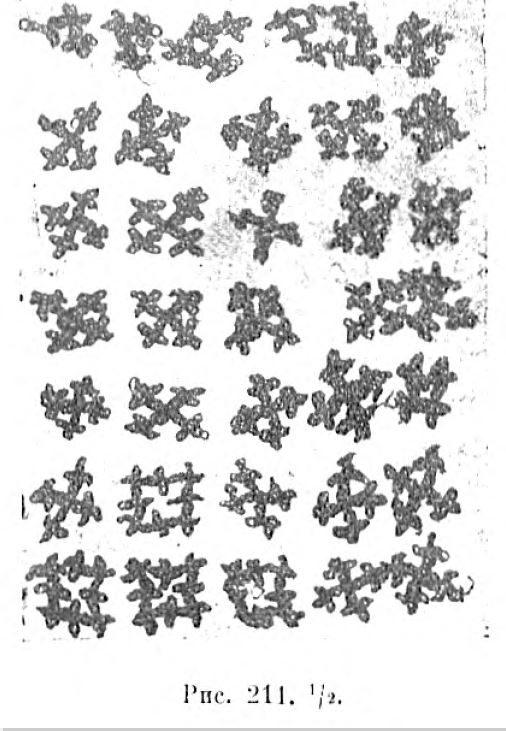
Russia, Suzdal – There are at least three examples of temple rings from 11th-13th century Suzdal that have knots similar to posament sliding knots, one example each of twisted wire, spiral wire, and smooth wire knots. Poor-quality images from graves 64 and 70 seem to show a total of four temple rings with knots, but it is not clear if those are four additional examples or these three rings and the fourth has been lost. (Book citation misplaced, images from Suzdal museum website.)
Suzdal also has a few examples of “buttonholes” and other textiles with spiral metal adornments, but these appear to be made of lahn as well as being a little late for the posaments (11th-13th century). “золотной нитью, накрученной тугой спиралью на толстую шелковую основу.” (gold thread wound with a tight spiral on a thick silk base.) (Мануал Жен.Костюм 13в). Burial 1 from mound 50 has a “braid” and burial 2 from mound 93 has “butonloops” that are very similar to a single strand P9. (Image from – Пуговицы XI–XVIII веков Государственный Владимиро-Суздальский музей page 39).
Swabia – Shoe of Philip of Swabia – 1208 – Ösenstich(?) with drawn wire and tabletwoven bands with gold lahn. (Dreyspring, Brigitte , Ina Meißner, and Sigrun Thiel. “Neueste Erkenntnisse zu den historischen Textilien der Kaiser und König aus dem Dom zu Speyer.” In NESAT XI, 213-20. Leidorf: VML, 2013.)
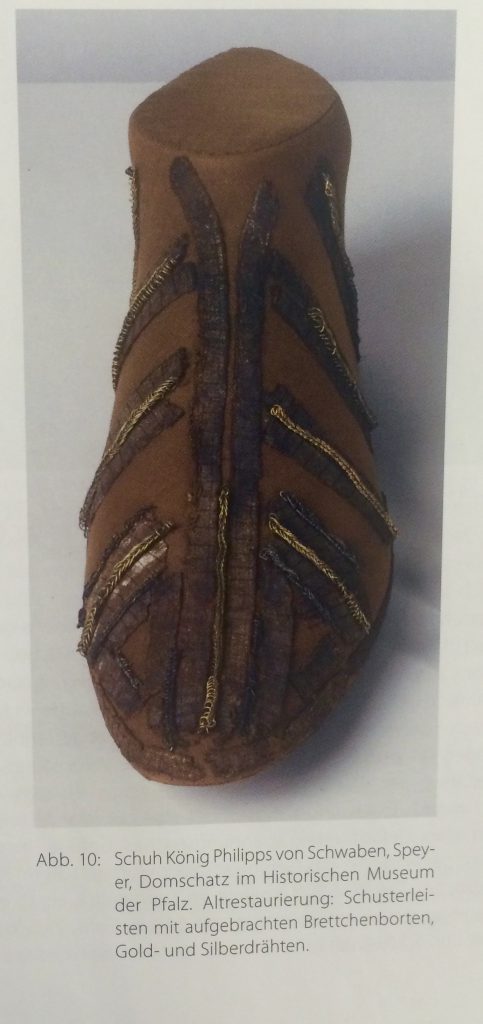
Switzerland, Sion – This item looks similar to the Birka posaments but is made of silk wound around linen. It also does not obey the grammar of the Birka or the Gotland posaments, having three strand per line. It is interested to consider whether this sort of textile knot could have occurred along with the metal Birka knots, but that is another topic for a later day. (Hägg, Inga. “Härskarsymbolik i Birkadräkten.” Dragt og magt (2003): 14-27, Schmedding Kat. Nr. 283 – pages 297-298)
